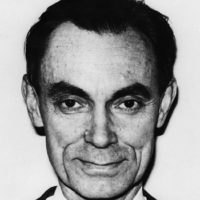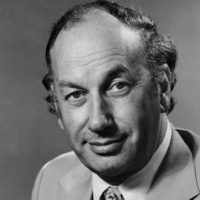
K. Sune D. Bergström
Karolinska Institute

Bengt Samuelsson
Karolinska Institute

John R. Vane
Wellcome Research Laboratories
For isolating and elucidating prostaglandins.
K. Sune D. Bergström
Prostaglandins are hormone-like substances, which have wide and significant effects in regulating many vital life processes. The importance of the role of these compounds has been appreciated only in the last decade.
Bergström is the acknowledged world leader in the prostaglandin field. He and his colleagues discovered several functions of prostaglandins, and explored their clinical utility.
One type of prostaglandin E prevents platelets—a blood constituent—from clotting. This discovery is expected to be applied clinically against heart attacks and strokes caused by clots. These prostaglandins, by inhibiting the secretion of gastric acid in the stomach, may also by useful in the treatment of gastric ulcer.
The second E-type prostaglandin, a powerful dilator of blood vessels, has been found in animal experiments to reduce high blood pressure—another cause of heart attacks and stroke. Such blood pressure reduction appears to be the result of accelerated water excretion and inhibition of sodium retention.
Bergström has also developed the clinical use of the strong uterus-contracting properties of prostaglandin F. This type of prostaglandin is now in rapidly increasing clinical use to induce labor at full term and to terminate pregnancy. This discovery has major implications for future research into the regulation of human fertility.
To Sune Bergström, who opened the door to new vistas of exciting and potentially clinically important medical discoveries, and stimulated an explosion of medical research by thousands of scientists the world over, this 1977 Albert Lasker Basic Medical Research Award is given.
Bengt Samuelsson
Bengt Samuelsson, first working with Sune Bergström on the structural elucidation of prostaglandins, later carried out independent studies which demonstrated that a fatty acid compound called arachidonic acid is the precursor of prostaglandins.
He further discovered that when arachidonic acid is combined with molecular oxygen, it leads to the formation of compounds called endoperoxides, and that these are essential to all prostaglandin metabolism. He subsequently showed that under certain conditions, the release of endoperoxides causes blood platelet aggregation. This information provides a new avenue of study for the causation of coronary occlusion and stroke, the major killers in the western world.
Bengt Samuelsson also elucidated the structure of an entirely new compound, thromboxane A2, a product of prostaglandin metabolism, and showed it to be a potent stimulator of platelet aggregation, and a constrictor of the large blood vessels and bronchi.
His techniques have made possible analysis and measurement of many biologically important compounds previously considered unmeasurable.
To Bengt Samuelsson, for creating new methods that give us new insights into the effects of prostaglandins on the functions of the body, this 1977 Albert Lasker Basic Medical Research Award is given.
John Vane
For his discovery of prostaglandin X, now renamed prostacyclin, whose major action is to prevent the formation of the kind of blood clots that may lead to heart attack and stroke.
Prior to John Vane's discovery, the reason why platelets sometimes adhere to the walls of arteries, thus contributing to the cause of heart attacks, was not known.
John Vane and his colleagues have shown that the walls of blood vessels produce prostacyclin, which prevents platelets from clumping. However, if the arterial wall is damaged by vascular disease or injury, this effect can be lost, and, as a consequence, the clumping of platelets is not prevented.
Another significant milestone was John Vane's discovery that aspirin-like drugs inhibit the formation of prostaglandins. He proposed that this action is the basis of aspirin's therapeutic effects, a theory now widely accepted. This would mean that a prostaglandin is involved in, or contributes to fever, pain and inflammation.
John Vane devised a simple method for the bioassay of prostaglandins, which he and his colleagues have used over the years. This has resulted in a new body of knowledge about the role which prostaglandins play in health and disease.
To John Vane, for these outstanding contributions which may lead to the development of therapeutic medicines against heart attack and stroke, this 1977 Albert Lasker Basic Medical Research Award is given.
Acceptance Remarks
Acceptance remarks, 1977 Lasker Awards Ceremony
In accepting this award, I would first like to acknowledge my great personal scientific indebtedness to this country. For my periods of training at Columbia University and the Squibb Institutes in the early 1940s, for the support of the National Institutes of Health in building up my research team in the 1950s and for the support at the crucial time of our prostaglandin work, followed by 20 years of stimulating cooperation with the Upjohn Company, where Dr. David Weisblat organized an outstanding research and development program that also included the distribution of thousands of samples to research workers around the world, making possible the rapid and expansive exploration of the programs of thousands of analogues in many biomedical fields.
But the most urgent medical problems, today, are not in our industrialized countries, but in the developing world—comprising about two-thirds of mankind. The one common denominator in all these different countries is the desire of each individual to get enough food and decent medical care. However, our knowledge of many types of disease is very limited—with better preventive and curative methods, this situation could be radically changed very fast. A larger part of the biomedical research potential of our industrialized countries must thus be mobilized for this purpose.
With the commitment of part of the enormous resources of the United States, the biomedical sciences of your pharmaceutical industrialists and relevant agencies, the new knowledge and methods emerging from such a cooperative endeavor would make it possible to fulfill each goal of the World Health Organization—to reach every child with preventative measures by 1990 and provide decent primary health care for everybody by the end of the century.
There are many encouraging signs of the United States participating in this endeavor. One is certainly the increasing international focalization of the prestigious Lasker Foundation. It is in this period of increasing international cooperation in all the health sciences that I gratefully accept this Award.
Acceptance remarks, 1977 Lasker Awards Ceremony
This year the Albert Lasker Medical Research Award is honoring prostaglandin and thromboxane research. It is a great honor and privilege for me to accept the award.
I am particularly pleased to share this award with Sune Bergström and John Vane. I got my initial training as a graduate student with Sune Bergström and, subsequently, had a most rewarding collaboration with him concerning the structure of the prostaglandins. John Vane and I have, over the past few years, had an extensive and very pleasant exchange of ideas and results and used methods developed in each of the two laboratories.
I would also like to acknowledge my debt to E.J. Corey, with whom I spent a most profitable post-doctoral year in the chemistry department at Harvard University. This stay in Corey’s laboratory had a profound influence on the direction of my scientific world.
Although this award is given to individuals, I must emphasize that science is a communal effort. What we have accomplished has rested on the achievements of those who preceded us, and the results from my own laboratory are due to devoted and intelligent work by many individuals from several countries. I would also like to acknowledge the important contributions of the institutions that have generously supported our research. In this context, it always gives me great pleasure to see basic research being recognized, since this is a prerequisite for advances in many different areas and it requires a fair support.
The recognition today indicates that our area of research has reached a certain degree of maturity. However, we have just obtained the tools for further exploration of this field of research, especially in the direction of physiology, disease processes, and therapeutics. I expect that prostaglandin and thromboxane research will also in the future provide many joyful moments for the discoverers and produce results which will benefit mankind.
Acceptance remarks, 1977 Lasker Awards Ceremony
This year, the Albert and Mary Lasker Foundation have honored prostaglandin research. The body has been making prostaglandins for millions of years, yet they were only discovered 40 years ago. Still, there is much left to discover and I am tremendously excited by the prospects of what prostaglandin research will show in the next ten years.
This award is a recognition of fundamental research; not just of the study of new chemicals, but the amassing of knowledge about the functions of the body which alone can lay the foundations for radical new methods of preventing and treating disease in the future.
It is a recognition of collaboration between academic research laboratories and those of the pharmaceutical industry. Above all, it is a recognition of the international nature of research. My own research team over the last decade has included leading scientists from ten countries besides my own, and a host of helpers from all parts of the world.
From the United Kingdom to Sweden to the United States and back again, the discoveries of the prostaglandins have flowed in a steady progression with one group of scientists adding to the work of another. I am particularly pleased to share this award, not only with Sune Bergström, the “father” of prostaglandin chemistry, but also with Bengt Samuelsson. His work and mine have interconnected in a specially pleasing and complementary way. Each of us has used completely different methods and different expertise to build on the discoveries of the other.
In my own case, I like to think that the award is also a recognition of the value of simple methods of research because it was the devising of a simple bioassay technique which enabled us to make and develop our discoveries in the prostaglandin field.
Often a scientific award marks the end of a story. In the case of prostaglandins, I think it marks the beginning—in fact, a number of beginnings. I hope I shall be fortunate enough to see at least one of them come to fruition in a way that helps mankind.
